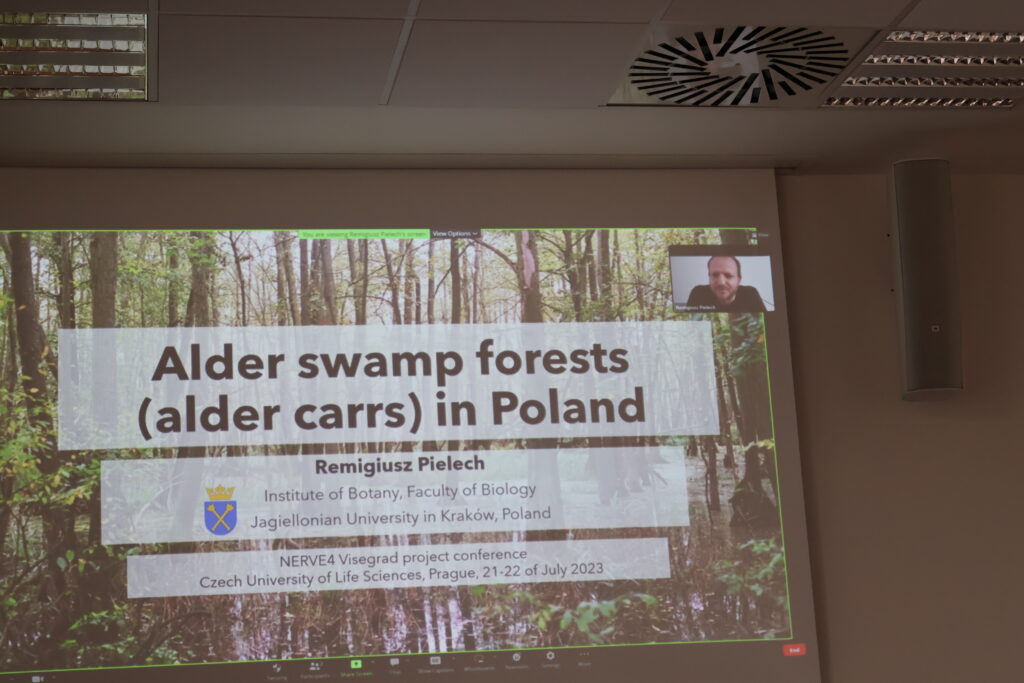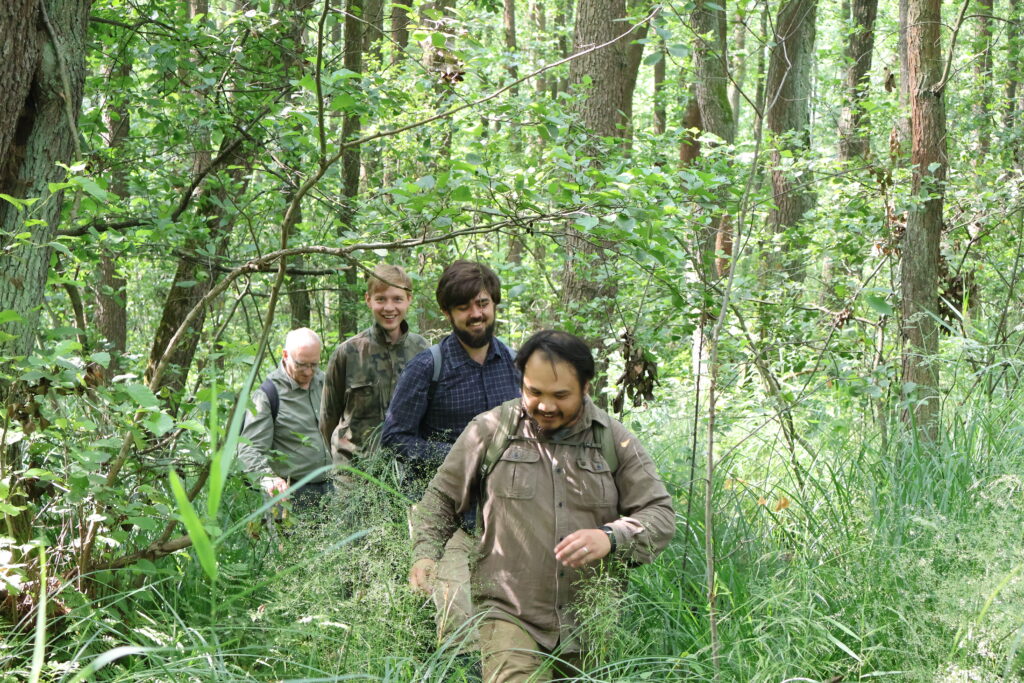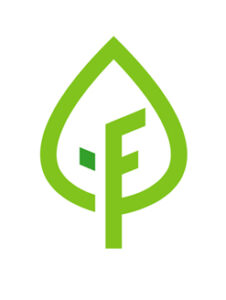NERVE4 Action
NERVE4 Action Conference meeting
Everything started day earlier then official start of the Conference. On the evening of 20th July, all the project participants arrived and were lodged in the quest dormitorie at the Czech University of Life Sciences. One major advantage of this accomodation was its convenient location near the Faculty of Environmental Sciences, where the conference meeting was held, in addition to its cost-effectiveness compared to other options. All quest were quite pleased with the quality of the lodgings.
The following day started on time, with attendes coming into the meeting room around 9:30. They each received a welcome package that included a day’s schedule and a notebook for note-taking. Catering food was already prepared, offering an extra morning meal option. The time before the opening speech was a chance for all to greet and meet, particularly for those meeting each other in person for the first time. Overall, the conference hosted 11 attendees, a somewhat smaller group than we originally anticipated. While our initial plan was to include practitioners and members of the public, we eventually shifted the focus to make it more of an internal team event.This gave us a great opportunity to discuss our findings, strengthen our working relationships, and collaborate on the creation of an educational brochure.
Time schedule
Day 1 (Conference Day):
9:00-10:00 – Registration & Welcome Coffee
10:00-10:15 – Opening Ceremony: Welcome speech by the host, introductions.
10:15-11:00 – Keynote Speaker Patricia Rodríguez González
11:00-11:30 – Coffee Break
11:30-12:30 – Section 1: Wetland forests in Visegrad countries and their management (15 minutes) –
Cover the most interesting and highest quality localities and overall conditions in your country.
12:30-13:30 – Lunch Break
13:30-15:00 – Section 2: Ecology of wetland forests and similar biotopes + garden experiment
excursion
15:00-15:30 – Coffee Break
15:30-16:00 – Section 3: NERVE4 project summary and panel discussion
16:00-16:30 – Summary and announcement of next day’s excursion
18:45-22:00 – Networking Dinner
Day 2 (Excursion Day):
7:00-9:00 – Travel to the excursion locality Černiš
9:00-12:00 – Excursion to the alder carr Černiš
12:00-13:00 – Lunch at České Budějovice restaurant Lokotka
13:00-15:00 – Coming back and end of the meeting conference
Project expert participation: Ferenc Horváth, PhD; Remigiusz Pielech, PhD; Michal Slezák, PhD; Jan Douda, PhD;
Other attendees: Patricia María Rodríguez González, Phd (Honored quest); Leandro Eusebio; Kacper Foremnik; Bartłomiej Surmacz; Anežka Holeštová, Jan Häusler, Přemysl Král
Start of the meeting
The formal inauguration of the event was marked by an introduction by Přemysl, who extended his gratitude to all attendees and provided a thorough walk-through of the agenda. Concluding his speech, he welcomed and introduced the opening keynote speaker, Patricia María Rodríguez Gonzáles, an authority on alluvial forests and their preservation from The University of Lisbon. Her enlightening presentation, focused on her research in Portugal and Northern Spain, not only added value to the meeting but also potentially paved the way for future collaboration with Portugal. Comparing the conditions between Central Europe and Western Europe was very interesting.

After a short break, designed to link sections with periods of relaxation, we initiated our first section. During this section, a delegate from each country prepared a presentation on the situation of Alder carrs and pinpointed a few exceptional localities that will be highlighted in the educational brochure. Unfortunately, Remigiusz had to leave prematurely due to an urgent family situation, but he was so committed that he presented remotely. His compelling presentation was delivered online to our gathering. Following the first session, we collectively take lunch at the local university restaurant.

The second session was designed to be more open-ended, encouraging discussion about wetland forests from various perspectives. In total, we had three presentations. The first was given by Jan Douda on the dynamics of alder carrs, Ferenc followed with a talk on Forest monitoring projects in Hungary, and lastly, Michal added a short presentation. After the presentations, we invited the whole group to explore our garden experiment with wetland plant species, and their interactions in different combinations and environmental conditions.

The official conference concluded with a concise recap of the day’s events, followed by an extensive discussion about the project and its outcomes. Přemysl shared some data from field level loggers and data plots, that might be included in the brochure. Data on species from this season remains to be analyzed, post which we can assess the dynamics of species with respect to water level differences. The agenda ended with a networking dinner at a traditional Czech pub. But before heading there, we had some free time, which we utilized for a leisurely walk through the Old City of Prague.

Excursion to the field
The next day was marked for a field trip to the Černiš project site, an alder carr situated on the periphery of the city of České Budějovice. As this location had been frequently referred to during Friday’s presentations, it offered an ideal setting for our excursion. The site is roughly a two-hour journey from the university in Prague, necessitating an early departure from Prague at 7:00 AM.

We reached the destination as per the itinerary and embarked on our journey into the forest. We traversed the heart of the site, arguably one of its oldest sections, which bore a resemblance to a virgin forest, and which also housed our sampling plots and data loggers. As we journeyed, we examined the species and ecology of the forest, eventually reaching the younger part, which presented a stark contrast due to the lack of reed expansion and smaller hummocks. The age differentiation between forest sections was researcher in past through core examination of the trees and historical map reviews, offering insights into the former non-forested areas. One participant had a close encounter with the terrain, nearly losing his gumshoe in the mud following an wrong step, fortunately, no water was present above ground during our visit.

On our return, we bid farewell to most of the attendees at the train station. Our final task involved escorting Patricia to the airport, thereby marking the successful conclusion of our meeting.
The project is co-financed by the Governments of Czechia, Hungary, Poland and Slovakia through Visegrad Grants from International Visegrad Fund. The mission of the fund is to advance ideas for sustainable regional cooperation in Central Europe.
https://www.visegradfund.org/

Participants

Czech University of Life Sciences Prague, Faculty of Environmental Sciences
Centre for Ecological Research, Institute of Ecology and Botany

University of Agriculture in Kraków, Faculty of Forestry

